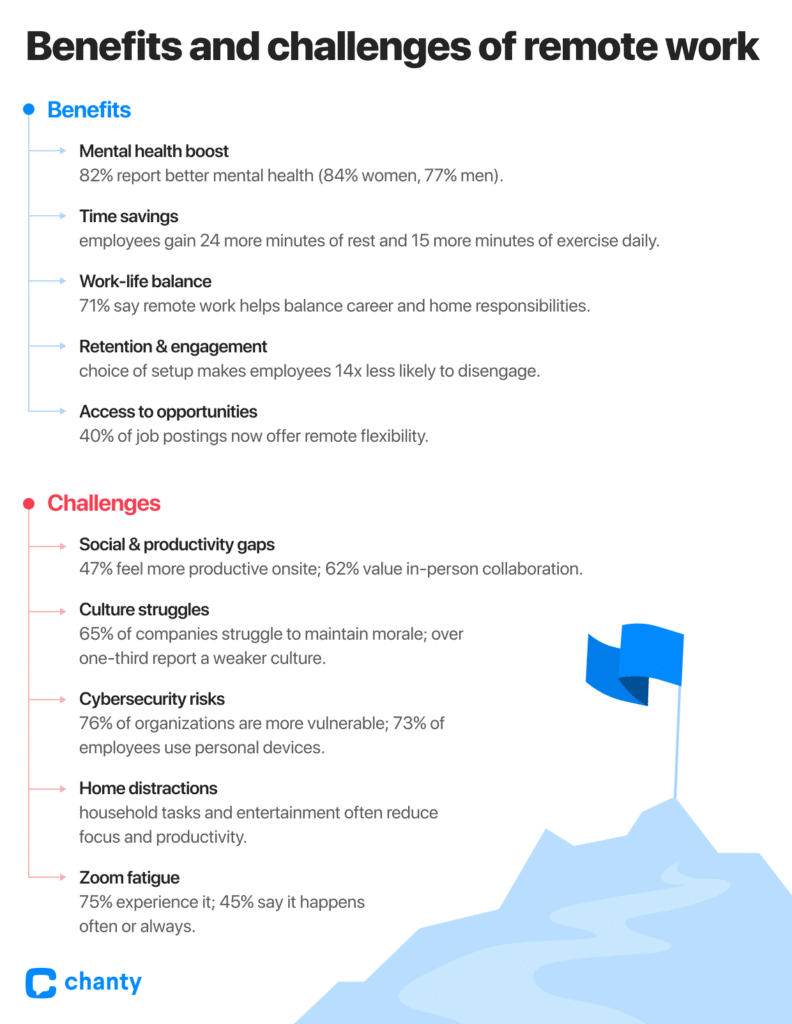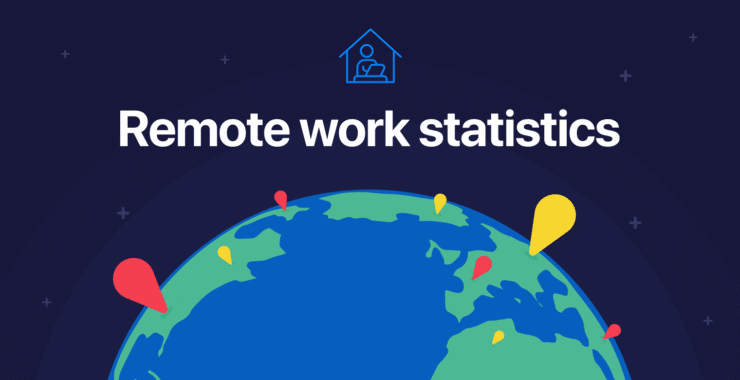It feels like we’re caught between two worlds right now. On one side, the comfort of working from home – the quiet mornings, no commute, the familiar rhythm of logging in from the kitchen table. On the other hand, the old pull of the office, with its buzz, the face-to-face talks, the endless meetings, and the sense of being constantly “watched.”
That’s why the latest remote work statistics 2025 matter so much. They cut through the noise and tell us what’s really happening. They highlight the benefits we can’t ignore, from flexibility and talent retention to productivity gains, alongside the challenges we need to address, such as isolation, burnout, and management struggles.
In the sections ahead, we’ll walk through the numbers shaping remote work right now. The good, the bad, and the future that’s unfolding, whether this model keeps expanding, levels off, or gets squeezed by the push to bring everyone back to the office. It’s a story every employer and employee is already living, and the stats make it impossible to look away.
Remote work statistics 2025 everyone is talking about
If the RTO wave makes it seem like remote work is losing steam, the numbers tell a more complex, and honestly, more interesting story. These are some of the most discussed remote work statistics 2025, painting a picture of what’s really happening behind all the noise.
- Gallup reports that among remote-capable U.S. employees, 52% are hybrid, 27% are fully remote, and only 21% are fully on-site.
Translation: the “five days in the office” era is already gone for good. Hybrid has become the dominant model, not the exception. - 83% of global employees say they prefer a hybrid setup that mixes remote and in-office days.
Employees aren’t just doing hybrid because companies push it – they actually want it. The preference is global, not just an American trend. - In 2025, 79% of remote professionals report lower stress levels, and 82% say their mental health is better with flexible work.
That’s a direct challenge to RTO arguments that office life “supports people better.” For most workers, flexibility itself is the support. - About 1 in 4 U.S. employees work remotely at least some hours, according to the BLS.
Even outside “remote-capable” jobs, the shift has spread further than many leaders admit. - According to Buffer, 98% of workers want to work remotely at least some of the time.
That’s near-unanimous. Employers might debate the model, but employees have already chosen. - Remote (40%) and hybrid work (38%) are linked to slightly higher reports of anxiety and depression compared to in-person work (35%).
The flexibility has real upsides, but it also creates new pressures – isolation, blurred boundaries, and the “always on” effect. - 61% of remote workers say they are more productive at home, while 81.4% report improved work-life balance.
Productivity and balance are exactly what companies claim to want – and the remote model is delivering them. - Remote work is strongest in English-speaking countries, where employees average about 2 days a week from home.
Culture matters. Remote work hasn’t landed equally everywhere, but in the U.S., U.K., Canada, and Australia, it’s already standard practice. - Hybrid job postings grew from 15% in mid-2023 to nearly a quarter (24%) of all new jobs by mid-2025.
Meanwhile, fully in-office postings continue to decline. The market itself is shifting toward flexible arrangements, regardless of corporate RTO pushes. - A new 2025 Deloitte survey shows that 65% of Gen Z and Millennials say they would leave their job if forced back to the office full-time.
This isn’t just preference – it’s a generational shift in how work is negotiated. For younger workers, flexibility is non-negotiable.
Taken together, these numbers show what policy debates often miss: remote and hybrid work are not temporary perks. They’ve become a structural expectation, reshaping how people measure productivity, well-being, and even loyalty to employers.

The Push back to office life: RTO trends and employee reactions
In 2025, the debate over returning to the office is louder than ever. Big names like Amazon, Dell, Apple, Google, IBM, Meta, and Salesforce are pushing employees back at least three days a week, sometimes even five. Headlines make it sound like everyone is going back, but the reality is far messier.
Over 32.6 million Americans are still working remotely, according to remote work adoption statistics, showing that remote and hybrid models aren’t a passing trend – they’re now a core part of modern work life.
A recent KPMG survey revealed:
- 8 in 10 CEOs envision a full return to the office within three years (up from 34% earlier this year).
- 86% of CEOs plan to reward employees who come into the office with favorable assignments, raises, or promotions.
Most employees aren’t thrilled about losing flexibility. Many even say they’d give up 10% of their salary just to keep working from home. On top of that, remote work saves around $7,000 a year on commuting, lunches, and office-related costs. But the biggest value lies beyond money – it gives people control over their environment and a sense of stability that’s priceless in today’s unpredictable world.
Yet companies see it differently. Larger organizations often implement structured hybrid models:
- 73% require office attendance, averaging three days per week.
- Some allow teams to choose which days, but most expect consistency across the organization.
- These setups aim to preserve collaboration and operational cohesion.
- 85% of leaders report struggling to trust productivity in hybrid setups, a “productivity paranoia” that is pushing some organizations to double down on RTO rules, tracking attendance and engagement more closely.
Yet strict RTO policies have consequences: nearly 8 in 10 enterprises report losing talent due to rigid mandates.
Global patterns vary:
- U.S.: Hybrid schedules usually mean 2 – 3 office days a week. A Business Insider survey shows 34% of employees must now be on-site four days, up from 23% in 2023.
- Europe: In the Netherlands, Ireland, Finland, and Germany, over 70% of employees work remotely fully or partially. Many countries are also testing a 4-day workweek.
- Global: Remote averages differ – English-speaking countries typically allow 1.5–2 days of remote work weekly, while many European nations hover closer to 1–1.5 days, shaped by labour laws and workplace culture.
Still, not everyone wants to stay home. Many miss office interactions – coffee chats, spontaneous brainstorming, and shared energy. For them, hybrid schedules are ideal: enough in-person time to connect, yet plenty of remote days for focus and freedom.
The tension is real:
- Remote work champions emphasize autonomy, flexibility, and cost savings.
- RTO advocates focus on collaboration, culture, and visibility.
The employee engagement statistics show, that companies that thrive are not the ones forcing people back but those building hybrid systems that balance productivity with well-being. Ignore this divide, and the risks are clear: disengagement, turnover, and disconnected teams.
The real benefits of remote work in 2025
This structural shift carries real implications for employees’ daily lives. In 2025, the way people experience work and life is being redefined. In a world that often feels volatile and unpredictable, the ability to choose where you work isn’t just about comfort – it’s about stability, health, and access to opportunities that once seemed out of reach. The work-from-home data that follows illustrates just how much these benefits matter, grounding the numbers in realities we can all recognize.
Mental health as a foundation, not an afterthought
The mental health impact of flexible work is undeniable. 82% of professionals report better mental health when working remotely, with women showing even higher rates of improvement (84%) compared to men (77%). This isn’t a small detail. In an age where burnout is almost expected and workplace stress is the norm, being able to start your day in an environment you control – one that feels safe, quiet, and human – gives people a chance to actually preserve their mental well-being. Instead of draining energy in commutes or navigating tense office politics, workers are reclaiming space to breathe. That makes them sharper and more resilient when real challenges show up.
The hidden gift of time in remote work
Commuting used to be the invisible tax on every workday. Remote work hands that time back, and people are using it wisely. Research shows that employees working from home spend 24 more minutes sleeping or resting and 15 more minutes exercising or focusing on well-being compared to their office-bound peers. In practice, that could mean one extra gym session a week, a little more patience with family, or simply feeling less worn out on Friday afternoons. Over weeks and months, those “small” minutes turn into a better rhythm – one that sustains both performance and personal health in ways traditional office life rarely allows.
Balance that finally feels real
For years, companies talked about work-life balance as a slogan. Remote work has made it a reality for many. 71% of employees say remote work helps them balance their productivity with responsibilities at home. It’s not about doing less work – it’s about doing both sides of life better. A parent can pick up their child from school without sacrificing career growth. Someone managing a household can stay on top of chores without running themselves into the ground after a long commute. The world moves quickly, and responsibilities pile up; remote work is one of the few modern tools that actually helps keep both worlds in harmony.
Retention through freedom and flexibility
The data is clear: when people can choose their work setup, they’re not just happier – they’re more likely to stay. Employees who have the option of working onsite, hybrid, or remote are 14 times less likely to disengage and “quit and stay.” That’s a staggering number when you think about how costly turnover is for businesses. In practice, it means flexibility is one of the strongest levers companies have to keep their best people engaged. Workers don’t want to feel trapped, and when they’re given real freedom, loyalty follows.
Opportunities without borders
The job market itself is shifting under the weight of remote and hybrid models. 40% of job postings worldwide now offer some form of remote flexibility. For workers, this means you’re no longer limited to the companies within driving distance. A developer in a small Midwestern town can join a leading firm in Silicon Valley. A marketing professional in Florida can work for a London-based startup without leaving home. In a time when economic uncertainty makes opportunities feel scarce, remote work expands the map. It connects skilled workers to roles that match their talents, no matter where they are.
The challenges of remote work in 2025
For all its advantages, remote work isn’t a silver bullet. The same flexibility that gives people balance and freedom also creates new obstacles that can’t be ignored. After all, a better work-life rhythm, stronger mental health, and broader access to opportunities don’t erase the fact that remote setups can leave gaps – in culture, connection, and even productivity. And if the benefits of remote work are shaping the future of how we live, the challenges are shaping the reality of how we work together every day.
The social side still matters
Remote work doesn’t erase the value of being in the same room. 47% of employees feel more productive onsite, and 62% highlight the social benefits of in-person collaboration. This is exactly why hybrid arrangements dominate in 2025 – they allow workers to enjoy the safety and independence of remote work without losing the human connection that often fuels culture and creativity. It isn’t about dragging everyone back under one roof. It’s about designing systems that give people real choices while keeping workplaces human.
The culture gap in remote teams
For employers, one of the biggest challenges has been keeping morale and culture alive when teams are scattered. 65% of companies say they struggle to maintain morale, and more than one-third admit productivity and company culture are harder to manage in remote setups. Culture doesn’t just “happen” online. It requires intentional design, creative engagement strategies, and consistent communication. Without this, teams risk feeling more like a collection of freelancers than a unified organization.
Remote work cybersecurity risks
The shift to remote and hybrid setups has created new entry points for cybercriminals. 76% of cybersecurity professionals say their organization is more vulnerable to cyberattacks because of remote work. According to recent remote work cybersecurity statistics, 73% of remote employees admit using personal devices for work purposes, a habit that dramatically increases exposure to phishing, ransomware, and data leaks. For small and mid-sized businesses, the problem is even sharper – many lack enterprise-grade protections, leaving them open to costly breaches. Beyond technical damage, cybersecurity failures erode trust with customers and partners, undermining confidence in remote-first policies.
Home distractions that hurt productivity
The office may have its interruptions, but home comes with its own. Many telecommuters admit they’re tempted to watch TV, take a nap, or clean the house when work feels overwhelming. While this might sound trivial, those little breaks often pile up into lost productivity and creeping guilt – a cycle that can be difficult to break when no manager or team is physically present.
Screen fatigue and tools overload
Finally, there’s the reality of endless video calls. According to LiveCareer’s Workplace Technology Survey, three out of four employees experience “Zoom fatigue.” Roughly 30% say they sometimes feel drained, while 45% say it happens often or always. Virtual meetings keep teams connected, but they also demand unnatural levels of focus and energy. After enough hours in front of a webcam, even the most engaged employee can start to feel detached.

How remote work burnout impacts employees in 2025
Working from home often looks like the dream: no commute, more freedom, a desk that’s entirely yours. But in practice, many remote workers end up feeling like they never truly leave the office. The laptop sits open in the corner, the phone buzzes with Slack or email notifications, and with colleagues scattered across time zones, there’s always someone online waiting for a response. What started as flexibility can easily morph into an “always-on” reality where switching off feels impossible.
The remote work mental health paradox
Remote work has the potential to improve well-being, yet for many, it has exposed new vulnerabilities. Research shows that more than half of those whose depression worsened during remote work (56.7%) reported a negative work experience, compared to just 21.7% of those whose mental health remained stable.
On top of that, 67% of remote workers feel less connected to colleagues, and 56% say they struggle to disconnect after hours. The troubling part? Only 34% of employees report having meaningful mental health support from their employer. Flexibility alone can’t replace a sense of belonging or ease the isolation that comes with working at home. The emoji statistics show that small gestures like sharing a smiley can help foster a sense of connection and create a more approachable virtual environment.
Even something as simple as sharing an emoji can go a long way in bridging the gap and making remote interactions feel more personal and engaging.
Why does burnout happen in remote settings
Burnout in remote setups doesn’t only come from long hours. It grows from a constant, low-level pressure to stay available:
- Micromanagement and surveillance – 23% of employees feel constantly monitored online, correlating with an 18% rise in stress and anxiety.
- Unrealistic expectations – managers sometimes assume remote teams can do “more with less,” overlooking the unseen effort behind tasks.
- Visibility over value – 17% of workers feel pressured to “look active” online, rather than focus on meaningful outcomes.
Fewer breaks – 16% report lower quality and frequency of breaks, fueling fatigue. - Isolation – 67% of fully remote employees feel lonelier, which amplifies stress and erodes motivation.
The numbers behind burnout
- 86% of full-time remote workers report burnout, with 81% checking work emails outside regular hours.
- 63% work on weekends and 34% even during vacations, turning rest time into “shadow work.”
- 69% of remote workers say digital communication overload directly contributes to burnout.
- About 40% struggle to disconnect from work, making recovery harder.
More than workload
Burnout isn’t only about emails piling up or managers pushing too hard. Remote setups strip away the casual moments that recharge people – the coffee break chats, quick jokes by the printer, or spontaneous team lunches. Without these, even the most disciplined employee can feel stagnant and stuck.
Rebuilding balance
That’s why digital spaces for connection and collaboration are vital. Platforms like Chanty help recreate the human side of work by blending productivity and communication. With features like Kanban task boards, message-to-task conversion, and casual team channels for GIFs or emojis, such tools support both workflow and community. They help employees feel part of something larger than their to-do list – and that sense of belonging is often the best antidote to burnout.
In the end, remote work burnout isn’t about the format itself. It’s about how organizations manage expectations, foster connection, and respect boundaries. Without those, the freedom of remote work can easily turn into another trap of exhaustion.
The future of remote work in 2025 and beyond
After exploring the benefits and challenges of remote work, it’s clear that the story doesn’t end here. 2025 is shaping up as a year where flexibility isn’t just a perk – it’s becoming a baseline expectation, and companies that fail to adapt risk losing talent and productivity.
1. Hybrid work as the default
Hybrid isn’t a trend anymore – it’s the new normal. Hybrid job postings jumped from 15% in Q2 2023 to 24% in Q2 2025, while fully on-site roles continue to decline from 83% to 66%. This isn’t just a statistic; it’s a reflection of how organizations are acknowledging that employees want both autonomy and human connection. Hybrid allows people to get the safety, focus, and freedom of remote work while still keeping the social and creative sparks of the office alive.
2. Talent attraction and retention
Remote work is no longer optional for many professionals – it’s a deciding factor in whether they join or stay with a company. In the UK, 93% of workers said they would consider quitting if remote flexibility were revoked, and globally, employees with real choice in where to work are 14× more likely to stay. Flexibility is no longer just about comfort; it’s about survival in a highly competitive talent market.
3. Technology accelerates remote efficiency
The tools powering remote work are evolving at a rapid pace. AI-powered platforms like Zoom AI Companion, Google Meet with Gemini AI, and Slack AI are helping teams automate tasks, schedule meetings intelligently, and gain actionable insights without adding hours to the day. Meanwhile, cloud-based project management tools like ClickUp and Airtable make collaboration seamless, even across continents. These aren’t just conveniences – they’re the infrastructure allowing remote teams to function as smoothly as those in physical offices.
4. Balancing global adoption
Remote work is thriving unevenly around the world. In the U.S., over 32.6 million people work remotely, representing 22% of the workforce. In contrast, office-centric culture remains dominant in many East Asian countries. These differences aren’t just cultural – they affect talent mobility, international hiring strategies, and employee expectations. Companies that understand these nuances can tap into global talent while creating policies that fit diverse regional realities.
Remote work isn’t going anywhere
Remote work in 2025 isn’t some experiment anymore. It’s part of our daily routine. Millions of people wake up, make their coffee, log in, and start their day from home, a café, or wherever they can focus. Some days are quiet and productive, some days are full of back-to-back video calls, juggling deadlines, and trying to feel connected to colleagues who aren’t in the same room. This is the reality of work today, and it’s not going away.
The benefits are real. Flexibility lets people control their schedules, balance responsibilities, and work from anywhere. Work from home statistics show that employees often experience improved productivity and better work-life balance when given this freedom. The challenges are just as real. Zoom fatigue, blurred boundaries, and missing the energy of in-person collaboration are constant reminders that remote work isn’t perfect.
Work from home format is here to stay because it reflects how people want to work and how businesses can thrive in a fast, unpredictable, and constantly changing world. Remote work productivity statistics suggest that, when managed well, teams can maintain or even increase output while supporting employee well-being. It’s not about choosing convenience over results – it’s about shaping work so that productivity, mental health, and connection coexist.
Every workday today comes with choices, flexibility, and the daily challenges of working outside a traditional office. Understanding the benefits, facing the difficulties head-on, and building practical habits are what separates teams and people who thrive from those who just endure. The modern workplace has shifted, and the ones who succeed will be the ones who adapt with awareness, intention, and a little bit of grit.








